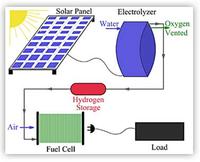-
Thumbnail-sized quantum cascade laser, tuning forks detect greenhouse gases
Human activities such as agriculture, fossil fuel combustion, wastewater management, and industrial processes are increasing the amount of nitrous oxide in the atmosphere. The warming impact of methane and nitrous oxide is more than 20 and 300 times, respectively, greater compared to the most prevalent greenhouse gas, carbon dioxide, over a 100-year period. Methane and nitrous oxide detection is crucial to environmental considerations. Scientists use a thumbnail-sized quantum cascade laser (QCL) as well as tuning forks that cost no more than a dime to detect very small amounts of nitrous oxide and methane.
-
-
Botwall: New Web security solution uses real-time polymorphism to ward off attacks
Malware has long used polymorphism — that is, rewriting its code — every time a new machine was infected in order easily to evade antivirus detection systems. Shape Security says its new product, the ShapeShifter, is reversing this advantage which malware has so far enjoyed: the new product uses polymorphic code as a new foundational tool for Web site defense. The patent-pending technology implements real-time polymorphism, or dynamically changing code, on any Web site, to remove the static elements that botnets and malware depend on for their attacks.
-
-
Turkeys inspire smartphone-capable early warning system for toxins
Some may think of turkeys as good for just lunch meat and holiday meals, but University of California, Berkeley bioengineers saw inspiration in the big birds for a new type of biosensor which changes color when exposed to chemical vapors. This feature makes the sensors valuable detectors of toxins or airborne pathogens. The technology can be adapted so that smartphones can help analyze the color fingerprint of the target chemical. In the future, it could potentially be used to create a breath test to detect cancer and other diseases.”
-
-
Highly sensitive tactile e-whiskers for robotics, other applications

From the world of nanotechnology we have gotten electronic skin, or e-skin, and electronic eye implants or e-eyes. Now we are on the verge of electronic whiskers. Researchers have created tactile sensors from composite films of carbon nanotubes and silver nanoparticles similar to the highly sensitive whiskers of cats and rats. E-whiskers could be used to mediate tactile sensing for the spatial mapping of nearby objects, and could also lead to wearable sensors for measuring heartbeat and pulse rate.
-
-
Quantum physics to make possible secure, single-use computer memories
Computer security systems may one day get a boost from quantum physics, as researchers have devised a way to make a security device that has proved notoriously difficult to build — a “one-shot” memory unit, whose contents can be read only a single time. One-shot memories would have a wide range of possible applications such as protecting the transfer of large sums of money electronically.
-
-
Carbon nanotubes improve flame-resistant coating
Using an approach akin to assembling a club sandwich at the nanoscale, researchers have succeeded in crafting a uniform, multi-walled carbon-nanotube-based coating that greatly reduces the flammability of foam commonly used in upholstered furniture and other soft furnishings. In tests, the flammability of the nanotube-coated polyurethane foam was reduced 35 percent compared with untreated foam. As important, the coating prevented melting and pooling of the foam, which generates additional flames that are a major contributor to the spread of fires.
-
-
Robots compete in performing emergency response task

Sixteen robots participating in the DARPA Robotics Challenge Trials last month performed such tasks as opening doors or climbing a ladder, all tasks aimed to speed the development of robots that could one day perform a number of critical, real-world, emergency response tasks at natural and human-made disaster sites. While most of the entries were engineered to resemble humanoids with two legs, JPL’s RoboSimian tackled tasks like climbing over rough terrain on all four of its limbs.
-
-
Harnessing solar energy during day for use at night

In one hour, the sun puts out enough energy to power every vehicle, factory, and device on the planet for an entire year. Solar panels can harness that energy to generate electricity during the day. The problem with the sun, however, is that it goes down at night — and with it the ability to power our homes and cars. If solar energy is going to have a shot at being a clean source of powering the planet, scientists had to figure out how to store it for night-time use. Researchers have built a system that converts the sun’s energy not into electricity but hydrogen fuel and stores it for later use, allowing us to power our devices long after the sun goes down.
-
-
Using building “belt” cheaply, quickly to repair of earthquake damage
Four years after the January 2010 earthquake, 145,000 people still remain homeless in Haiti. Researchers developed a cheap and simple technology to repair earthquake damaged buildings to help to reduce these delays by quickly making buildings safe and habitable. The technology involves wrapping metal straps around each floor of the building, which are then tensioned either by hand or using compressed air tools. Unlike other repair methods, it does not require expensive materials or a high level of technical knowledge, making it ideal for use in the developing world.
-
-
New test for detecting newly emerging strains of drug-resistant superbug
Molecular assays for MRSA are used in active surveillance programs to identify colonized patients rapidly. Active surveillance is a proven strategy to reduce transmission in healthcare settings and it helps prevent infection in vulnerable patients. BD Diagnostics has received FDA clearance to market the BD MAX MRSA XT Assay for use on the BD MAX System. This is the second assay from BD Diagnostics capable of detecting newly emerging MRSA strains with the novel mecC gene.
-
-
New phone alerts for extreme weather events may prevent casualties in India
India has a mobile phone subscriber base exceeding 929 million people and this is expected to touch 1.15 billion by the end of 2014. An alert system developed for mobiles could reach an estimated 97 percent of the population. Computer science undergraduates have created image-based mobile phone alerts, connected to the Weather Research and Forecasting system.
-
-
The benefits, challenges of self-driving cars
Self-driving vehicles offer the promise of significant benefits to society, but raise several policy challenges, including the need to update insurance liability regulations and privacy concerns such as who will control the data generated by this technology, according to a new RAND Corporation study. Researchers suggest that a guiding principle for policymaking is to encourage the technology when the facts indicate clear societal advantages over the capabilities of the average human driver.
-
-
“Power to gas”: Synthetic natural gas from excess electricity
“Power to gas” is a key concept when it comes to storing alternative energy. This process converts short-term excess electricity from photovoltaic systems and wind turbines into hydrogen. Combined with the greenhouse gas CO2, renewable hydrogen can be used to produce methane, which can be stored and distributed in the natural gas network. Researchers have now succeeded in further optimizing this process.
-
-
Eight teams heading to DARPA Robotics Challenge finals

Two weeks ago, on 20-21 December 2013, sixteen teams were the main attraction at the DARPA Robotics Challenge (DRC) Trials, where they demonstrated their prototype robots’ ability to perform a number of critical real-world disaster-response skills. After two days of competition, the agency selected eight teams to receive up to $1 million in funding to continue their work and prepare for upcoming DARPA Robotics Challenge (DRC) Finals.
-
-
New system uses low-power Wi-Fi signal to track moving humans -- even behind walls
The comic-book hero Superman uses his X-ray vision to spot bad guys lurking behind walls and other objects. Now we could all have X-ray vision, thanks to a new system developed by researchers at MIT. The system, called “Wi-Vi,” is based on a concept similar to radar and sonar imaging. But in contrast to radar and sonar, it transmits a low-power Wi-Fi signal and uses its reflections to track moving humans. It can do so even if the humans are in closed rooms or hiding behind a wall.
-
More headlines
The long view
New Technology is Keeping the Skies Safe
DHS S&T Baggage, Cargo, and People Screening (BCP) Program develops state-of-the-art screening solutions to help secure airspace, communities, and borders
Factories First: Winning the Drone War Before It Starts
Wars are won by factories before they are won on the battlefield,Martin C. Feldmann writes, noting that the United States lacks the manufacturing depth for the coming drone age. Rectifying this situation “will take far more than procurement tweaks,” Feldmann writes. “It demands a national-level, wartime-scale industrial mobilization.”
How Artificial General Intelligence Could Affect the Rise and Fall of Nations
Visions for potential AGI futures: A new report from RAND aims to stimulate thinking among policymakers about possible impacts of the development of artificial general intelligence (AGI) on geopolitics and the world order.
Keeping the Lights on with Nuclear Waste: Radiochemistry Transforms Nuclear Waste into Strategic Materials
How UNLV radiochemistry is pioneering the future of energy in the Southwest by salvaging strategic materials from nuclear dumps –and making it safe.
Model Predicts Long-Term Effects of Nuclear Waste on Underground Disposal Systems
The simulations matched results from an underground lab experiment in Switzerland, suggesting modeling could be used to validate the safety of nuclear disposal sites.
